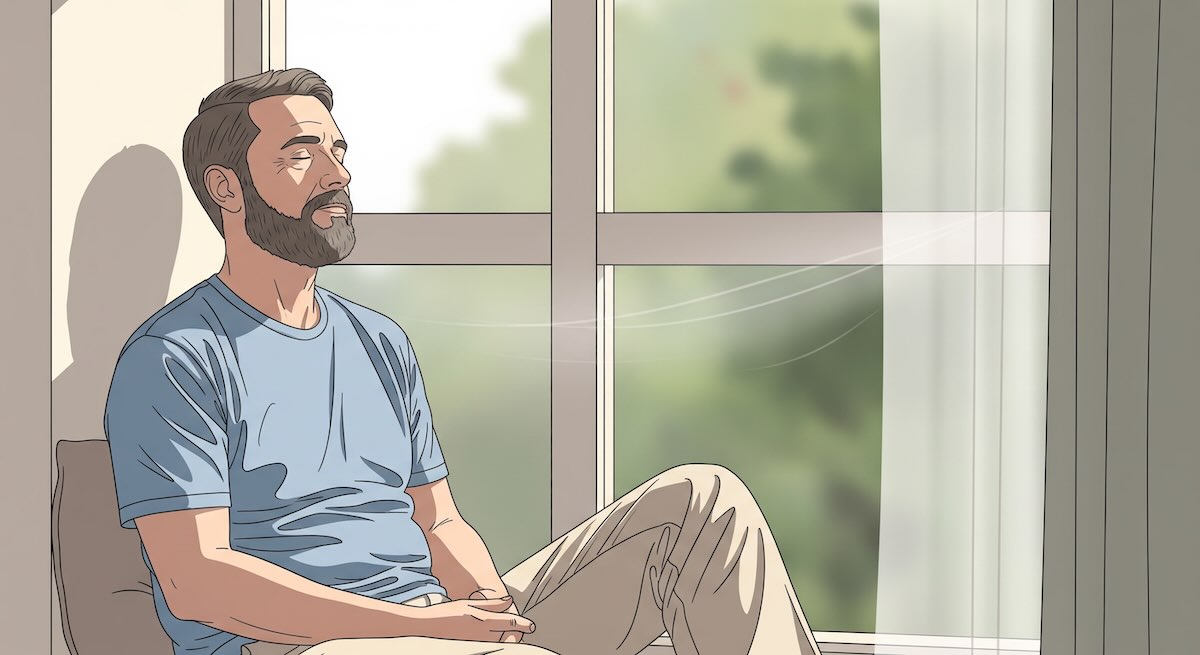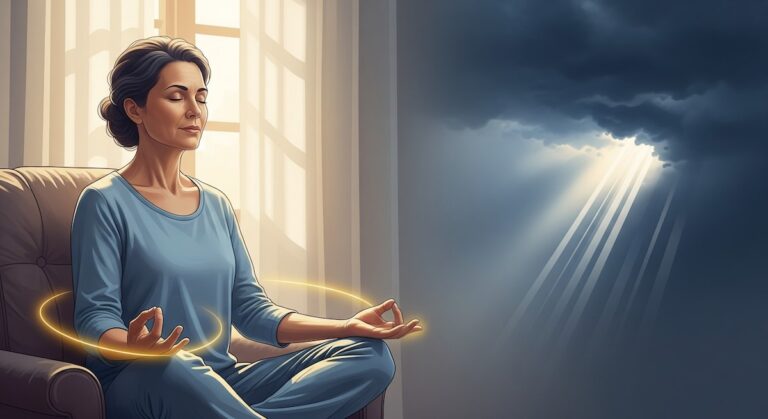That familiar tightness in your chest, the racing thoughts, the sense of unease or dread, anxiety can feel overwhelming and hijack your peace of mind. While it’s a common human experience, chronic anxiety can significantly impact your quality of life. The good news? You have tools available to help manage it, and meditation for anxiety is one of the most accessible and effective.
But how exactly does sitting quietly help untangle the knots of anxiety? This guide explores the science behind how meditation helps anxiety, introduces simple techniques you can use anytime, anywhere, and offers tips for integrating this practice into your life for lasting relief.
Understanding the Connection: How Does Meditation Help with Anxiety?
Anxiety often involves getting caught in cycles of worry about the future or rumination about the past. Your body’s “fight-or-flight” system might be chronically activated. Meditation works directly on these patterns:
- Calms the Nervous System: Like with sleep, meditation activates the parasympathetic nervous system (“rest-and-digest”), counteracting the physical symptoms of anxiety (rapid heartbeat, shallow breathing, muscle tension).
- Creates Distance from Anxious Thoughts: Mindfulness teaches you to observe thoughts and feelings without automatically identifying with them or believing they are absolute truths. You learn that thoughts are just mental events, not necessarily reality.
- Increases Present Moment Awareness: Anxiety often lives in “what ifs” and “should haves.” Meditation anchors you in the present moment, the only place where you can experience calm and take effective action.
- Develops Emotional Regulation Skills: By practicing noticing feelings without reacting impulsively, you build the capacity to handle difficult emotions, including anxiety, with greater ease.
- Changes Brain Structure: Research suggests regular meditation can decrease activity in the amygdala (the brain’s fear center) and increase connectivity in areas related to focus and self-awareness.
Best Meditation Techniques for Anxiety Relief
When anxiety strikes, or as a preventative measure, try these techniques:
1. Mindfulness of Breath (The Anchor)
- Why it works: Your breath is always available as a non-judgmental anchor to the present moment, instantly calming the nervous system.
- How-to: Find a comfortable seated position (or stand/lie down if needed). Gently close your eyes or soften your gaze. Bring your attention to the sensation of your breath entering and leaving your body. Notice where you feel it most (nostrils, chest, belly). Don’t try to change it. When anxious thoughts or feelings arise, acknowledge them gently (“Ah, worry”) and kindly guide your focus back to your breath. Repeat as many times as needed. Even 1-2 minutes can help.
2. Grounding Techniques (5-4-3-2-1 Method)
- Why it works: Pulls your attention out of racing thoughts and into your immediate physical surroundings, interrupting the anxiety spiral.
- How-to: Wherever you are, pause and gently notice:
- 5 things you can see: Look around and mentally name five objects without judgment.
- 4 things you can feel: Notice the texture of your clothes, the chair beneath you, the air on your skin, and your feet on the floor.
- 3 things you can hear: Listen for sounds near and far, a clock ticking, birds outside, and your own breathing.
- 2 things you can smell: Notice any scents in the air, pleasant or neutral.
- 1 thing you can taste: Notice the taste in your mouth or take a sip of water.
3. Loving-Kindness Meditation (Metta)
- Why it works: Counteracts feelings of self-criticism and fear by actively cultivating feelings of warmth, kindness, and compassion towards yourself and others.
- How-to: Sit comfortably. Bring to mind someone you care about easily. Silently repeat phrases like: “May you be happy. May you be healthy. May you be safe. May you live with ease.” Then, direct these same phrases towards yourself: “May I be happy. May I be healthy…” You can then extend this to neutral people and even difficult people (if ready), and finally to all beings.
Practical Tips for Meditating When Anxious
- Start Small & Be Consistent: Even 5 minutes daily is more effective than an hour once a week. Consistency builds the “muscle.”
- Don’t Fight the Anxiety: Trying to force anxiety away often makes it stronger. Instead, practice acknowledging it with kindness (“Okay, anxiety is here right now”) while gently returning focus to your breath or senses.
- Meditate During Mild Anxiety: Don’t wait until you’re calm. Practicing with mild anxiety helps you build skills for when it’s more intense. (For severe anxiety or panic, focus on grounding first).
- It’s Okay if Your Mind Races: That’s normal, especially with anxiety! The practice isn’t about stopping thoughts; it’s about noticing them and gently redirecting your attention. Each redirect is a success.
- Use Guided Meditations: Apps and online resources offer countless guided meditations specifically for anxiety, which can provide helpful structure.
Managing Expectations
Meditation isn’t a magic wand that instantly eliminates anxiety forever. It’s a practice that gradually helps you change your relationship with anxiety.
- Expect Ups and Downs: Some days will feel calmer than others.
- Notice Subtle Shifts: Progress might look like reacting less intensely, catching anxiety spirals sooner, or recovering more quickly.
- Be Patient & Kind: Learning takes time. Treat yourself with compassion.
- Consider Professional Help: Meditation is a powerful tool, but it can also complement therapy (like CBT or ACT) or other treatments, especially for persistent or severe anxiety.
Conclusion: Finding Your Calm Amidst the Storm
Anxiety doesn’t have to rule your life. By incorporating meditation for anxiety into your routine, you equip yourself with powerful tools to calm your nervous system, gain perspective on anxious thoughts, and anchor yourself in the present moment. Start with just a few minutes of mindful breathing today. With consistent practice and self-compassion, you can cultivate a greater sense of inner peace and resilience, even when the storms of anxiety arise.




